On the road that goes up from the bottom of the fjord where stretches the small town of Isafjördur, I find myself wanting to stay here. In this beautiful fjord, in this place at the end of Iceland that I like so much. Yet yesterday I wanted to leave, to start on the road and finish my bike trip. You never know what you really want. I have two weeks left. To pedal. To descend south, crossing the Westfjords and the Snaefellsnes peninsula.
A long tunnel is waiting for me at the exit of Isafjördur. A long black hole in the mountain. The water oozes on the rock and the echo of the cars looks like a roar from the depths. For six kilometers in the dark. As if I had to cross the depths, be reborn, to begin the end of my journey. Önundarfjördur finally appears and the places seem different. Always these large cliff-top mountains dotted with holes on each side of a tongue of seawater stretching inward. But more austere. Different.
Unlike the first part, where the road ran along the coast and ran the length of the fjords, here the path cuts through the heights of the big fingers of the peninsula. There is no road along the coast, not enough people. So the route is more difficult, more hilly. Mid-bitumen, mid-gravel road. I attack the ascent of the first pass 270 meters, the first of a long series spanning for the whole week and crosses the Gemlufallsheidi mountain range. The wind is strong but I still move under the darkening clouds. And then it is the ascent of the mountain pass Hrafnseyrarheidi at 552 meters. Bitumen has given way to the track and I push my bike at times. It is raining a bit and I think the week is going to be tough. The bad weather being at the rendezvous. Drivers encourage me and I persevere. At the top, at the top of the highest mountain pass, I have a moment of emotion. Quickly swept away by the gusts of wind that push me downhill. It is a festival of colors, orange, red, yellow which lines the valley on the other side. The beauty of leaves and herbs changing colors with the arrival of Autumn.
Arnarfjördur is one of the most beautiful fjords in the region, divided into several arms sinking into the land. It is early evening and I am blown away by the beauty of the place. But the wind has strengthened and the last twenty kilometers along the sea is a test for my tired legs. I lose my calm and send insults in the air, cries of pain and anger against this monster of power that prevents me from moving forward. The words disappear immediately, swept by the wind and I resign myself. I reach Dynjandi, a gigantic waterfall, at dusk. 93km on the counter. Two ascended passes. Mix of rain and sun. And half of the day with headwind. Iceland.
The next day, rain starts around 7am. It will not stop. The rain. The rain that I managed to avoid during the rest of the travel is caughting up with me. It is the beginning of a rainy week. Everyday. Sometimes just droplets. Often, good showers. And the storm at the end of the week. The great waterfall, nearly 100 meters high, looks gloomy in the bleak sky. A pass at 500m then another at 468m. I cross the highlands of the Dynjandisheidi range. They are covered with moraines and mosses. Some snowfields in the distance. And small lakes where wild swans and gray geese still roam. It is beautiful, this landscape so wild, so raw. The rain rages on me and the fog appears and disappears at the pace of the wind gusts. It is long. And painful. But lamenting is useless, I must continue to move forward. Advance, pedal to avoid catching cold. Impossible to stop. It is constant, permanent effort to escape the frozen fingers of the wind and rain.
A young Basque in the opposite direction stops his car to ask me if I need help. A few minutes later, an Icelandic guy with beard and finger rings calls me out of his open window and wants to take pictures of me. He is a photographer for a local newspaper and my presence on a bike in the rain seems to inspire him. So for a few minutes, I forget the cold and the effort and I become a star pedaling across the highlands of the Westfjords. He takes several pictures, my name and email and lets me continue my way. Will I actually appear in the pages of the local paper? Who knows?
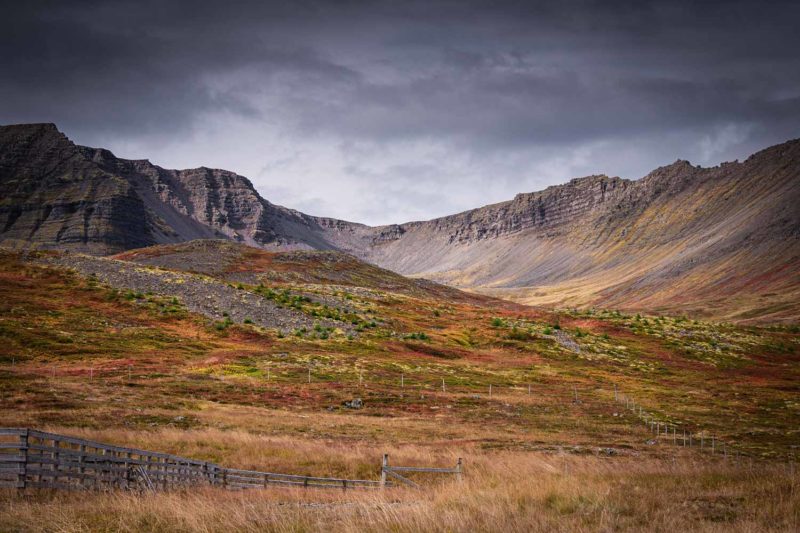
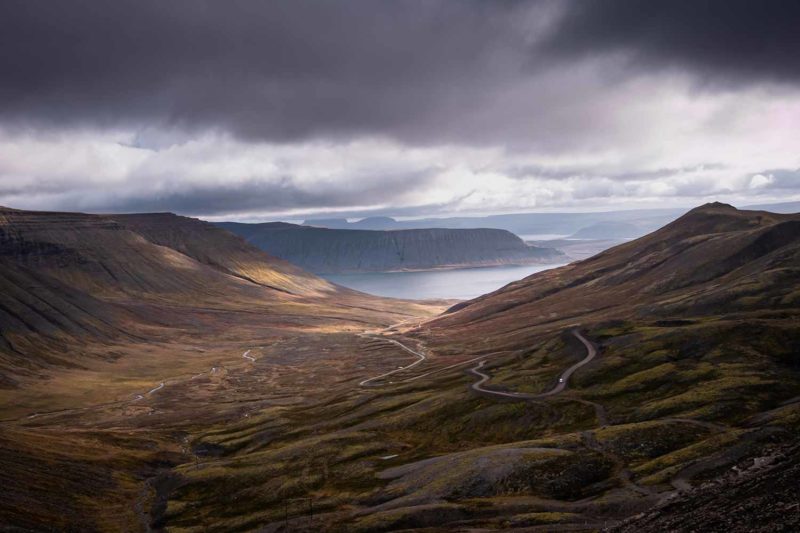
Hrafnseyrarheidi mountains.
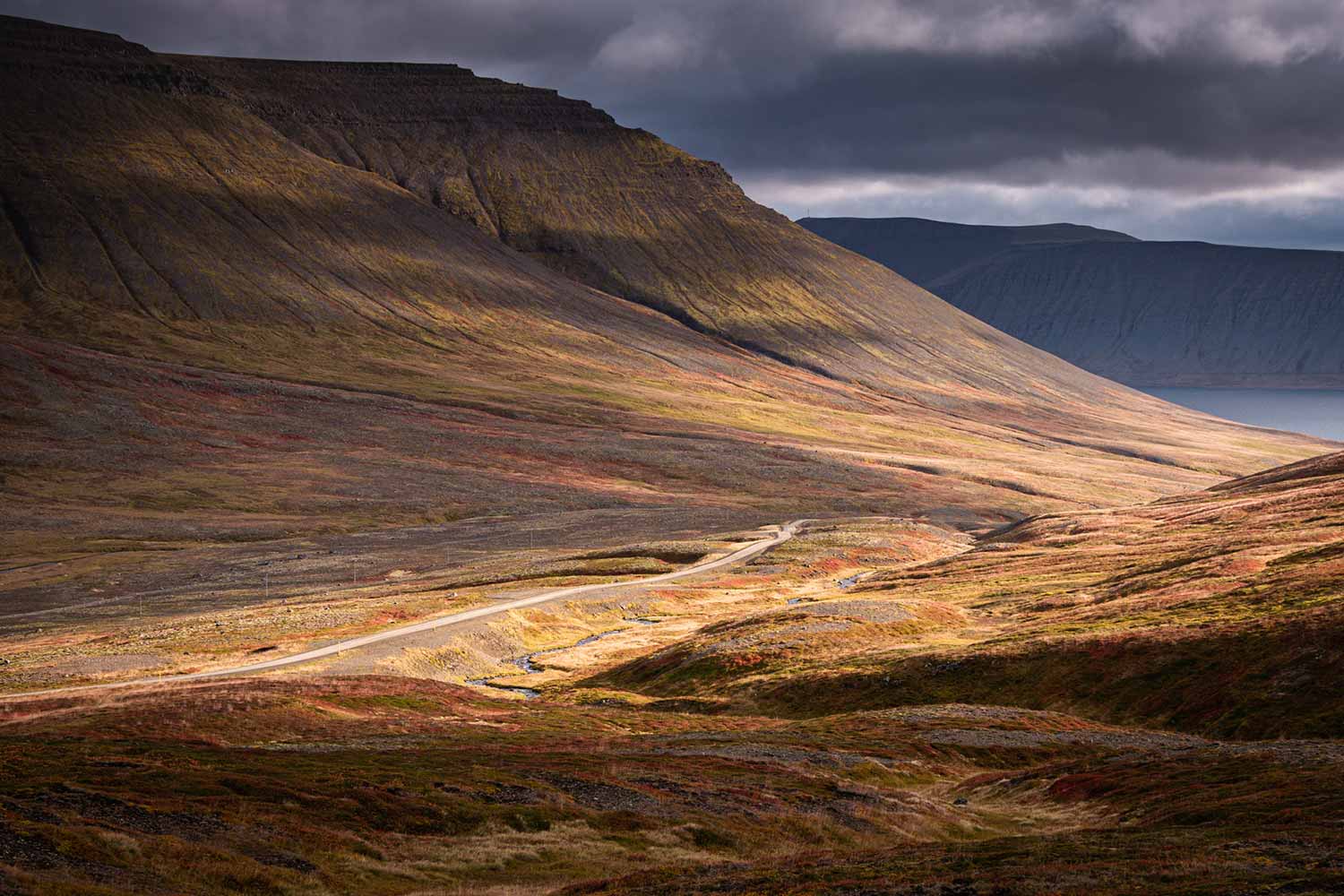
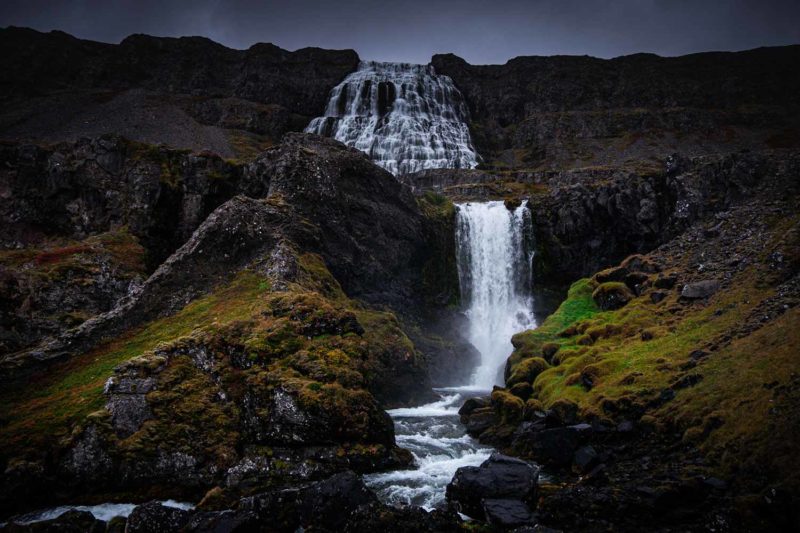
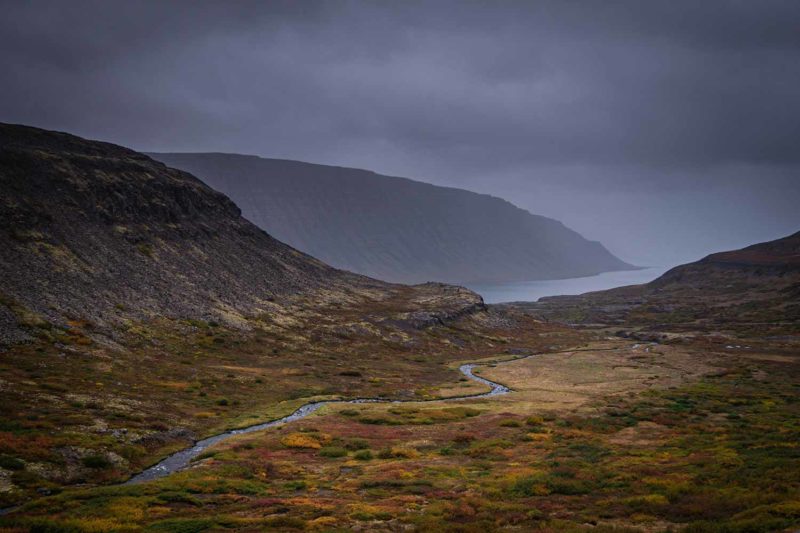
Dynjandi waterfall.
I go down on the other side, fingers white with cold but eyes dazzled by the colors of the small forest of dwarf birches lining the ground at the end of the fjord. I am hungry but it is still raining. Fortunately a small free swimming pool at the edge of the road, fed by a hot spring, will be my refuge. A small shed serves as a locker room and I take refuge inside for a quick meal. I want to immerse myself in the hot water but the idea of having to put my wet clothes on again to accomplish the remaining twenty kilometers prevents me. Bildudalur, a small port village finally appears in the middle of the afternoon. It is still raining. And I pitch my tent behind the sports center at the foot of the water. The lady at the front desk is impressed with my effort. She saw me this morning as I left the waterfall. She overtook me by car and thought that I really had courage to ride in the rain. I take advantage of the showers in the center and the sauna to warm me up. A good fish & chips and blueberry cheesecake will be my reward for this difficult day. Sheltered in the village’s only tiny restaurant, I watch the falling rain wondering if it will ever stop.
A ray of light crosses the walls of my tent covered with water and I wake up instantly. The rain has stopped. For the moment. And the sun that has just appeared is not yet obstructed by the clouds that dot the sky. A ray of heat. A ray of hope. What happiness! I attack the rise of Halfdan pass at 500m under a grey sky. My legs hurt but curiously the climb does not seem so hard. In the descent on the other side, a red car brakes at my level. This is the lady of the Bildudalur sports center. She offers to drop me at Patreksfjödur, about thirty kilometers away. But it is not raining and the sun illuminates at times the landscape so I decline nicely. I have to do the kilometers by myself. On the other side, attacking another pass at 369m, I tell myself that I should perhaps have accepted. But I slowly do the meters separating me from the top. My body is pedaling alone. Legs resigned to the effort required. Mind getting used to the slow and painful progression.
Patreksfjördur, the largest village on this side of the Westfjords finally appears in the middle of autumn colors. The forcing wind brings with it waves of rain. I see them curtaining in the distance to fall on me a few minutes later. Three sheep stand on a small sandbank in the middle of the water at the end of the fjord. Have they been trapped by the tide? A last pass at 350m on a battered track will complete to drain my last strength. But on the other side, ocean side, on the south coast of the Westfjords, hides a treasure. The red sandy beach of Rauðasandur. Hidden in a small bay, spreads a long tongue of orange sand. Not quite red as its name suggests, but for Icelanders accustomed to beaches of black sands, it must look red. Rainbows appear at intervals in the landscape and I forget the fatigue. Here, it is beautiful. The beach, the rainbows, the bay and the cliffs, this little place difficult to access has shot me an arrow in the heart. I join the small Melanes beach campsite and facing the rain and wind, spend the night in a small wooden cabin. A little hobbit hole. A protective cocoon. A refuge from the unleashed elements in this enchanting place.
The next day it is almost complete storm. So I wait in my cabin. I wait until mid-day that it calms a little so that I can leave. I regret that the weather is so bad. I would have really enjoyed staying here one more day, enjoying these beautiful places. But I have to cross the pass again in the opposite direction. On this side the climb is winding and despite the wind making me waltz and rain that persists, I do not find the climb so hard. Did I get accustomed to the habit of the effort to provide? I go down on the other side and continue the track along the coast. This is the last finger of the peninsula. At the far end, to the west is the great Latrabjarg cliff, famous for its bird colonies, including puffins. I have decided to go there. But given the difficulty of the road and the bad weather, I do not know if I will succeed. Hnjotur and its few houses appear in a small bay with a few rays of light. There is a guesthouse and a small museum. But the guesthouse is closed, its owner is in Reykjavik and does not return until tomorrow morning. I must continue. Twelve more kilometers and a 330 meters pass to reach Breidavik in another bay where a church and a hotel still open welcome me in the early evening. There are not many people and I take a room looking for comfort in the face of bad weather. Breakfast is included in the price. The prospect of eating something other than the same cereal for over a week makes me really happy.
I leave my bike and bags at the hotel the next day and I reach the road decided to hitchhike to get to the cliff and the most westerly place in Iceland. The rain and the wind will not stop me. Luckily, an American couple drops me thirty minutes later at the cliff. Here the wind is even stronger and the rain scrapes my face. I walk along the wall of steep stones for two kilometers scrutinizing the cliff but there is nothing here. Puffins are long gone and there is hardly a seagull left. The wind is angry and bursts almost sending me overboard. I am not even disappointed. Just resigned. It is Iceland. It is like that. I ride in the only car left in the parking lot that drops me off at the hotel around noon. Quiet lunch in the shelter, alone in the big room of the restaurant. The hotel closes tomorrow, Sunday. This is not the only one. The vast majority of accommodations close tomorrow. September 15th, Iceland puts the key under the door. Ciao Summer. Hello winter. The staff at the hotel seem slightly worried about letting me go in the storm. The owner, a very friendly lady with lots of enthusiasm tells me that it was sunny all summer. Until September 1st. Where the rain has arrived. Unlucky me. I leave in the opposite direction while the rain stops for a few hours and cross again the pass fighting with the wind. Only a few kilometers luckily to return to Hnjotur where I booked a night in the guesthouse whose owner has return from Reykjavik. The wind is far too strong to continue. And I do not want to force. Despite the difficult weather, I really like the place. I want to enjoy it.
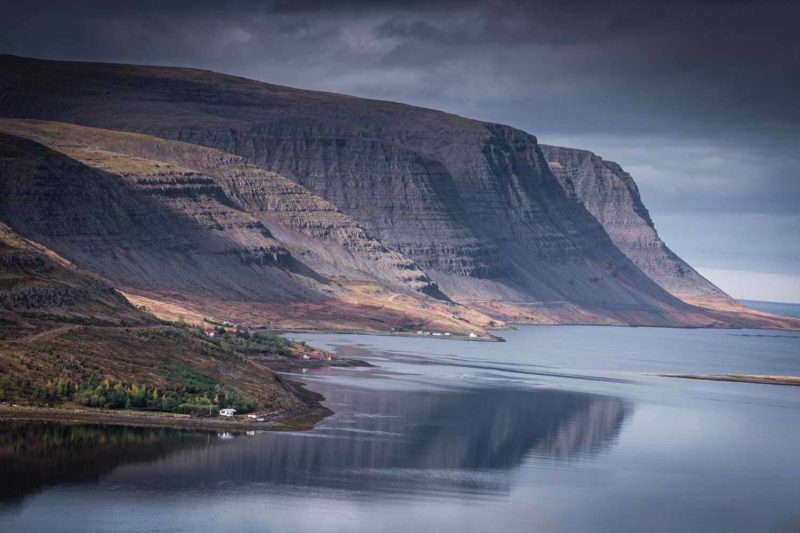
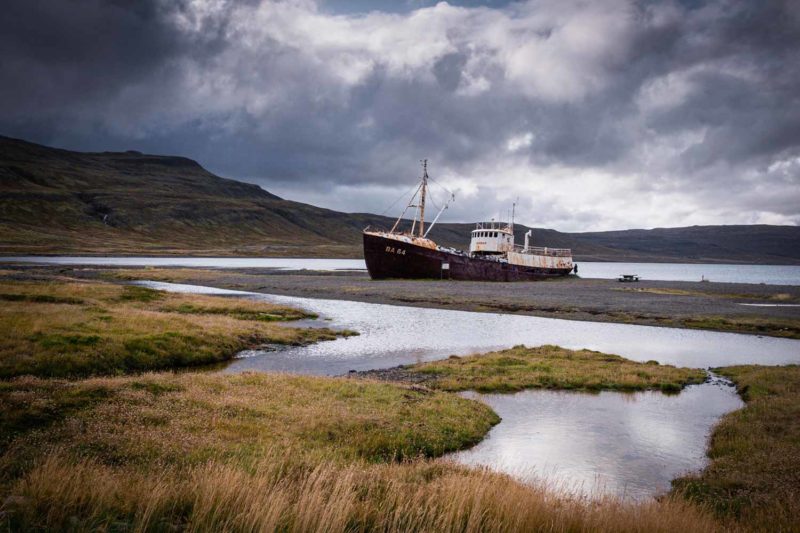
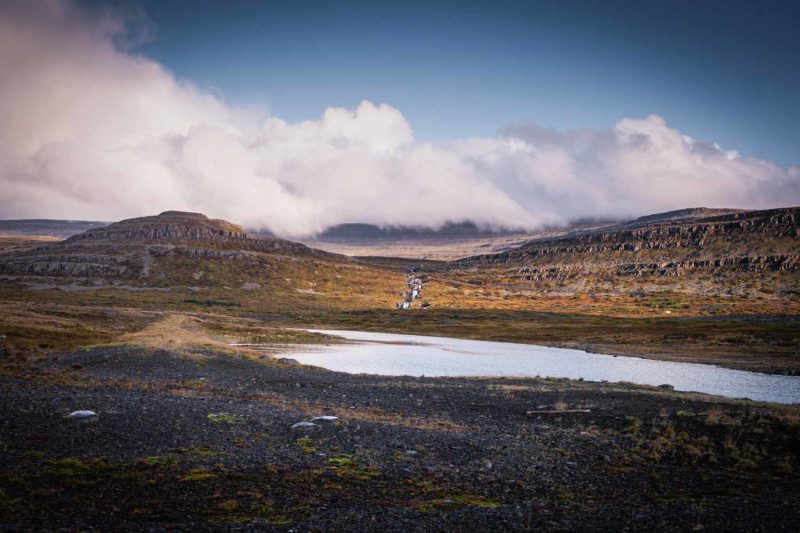

Raudasandur beach.
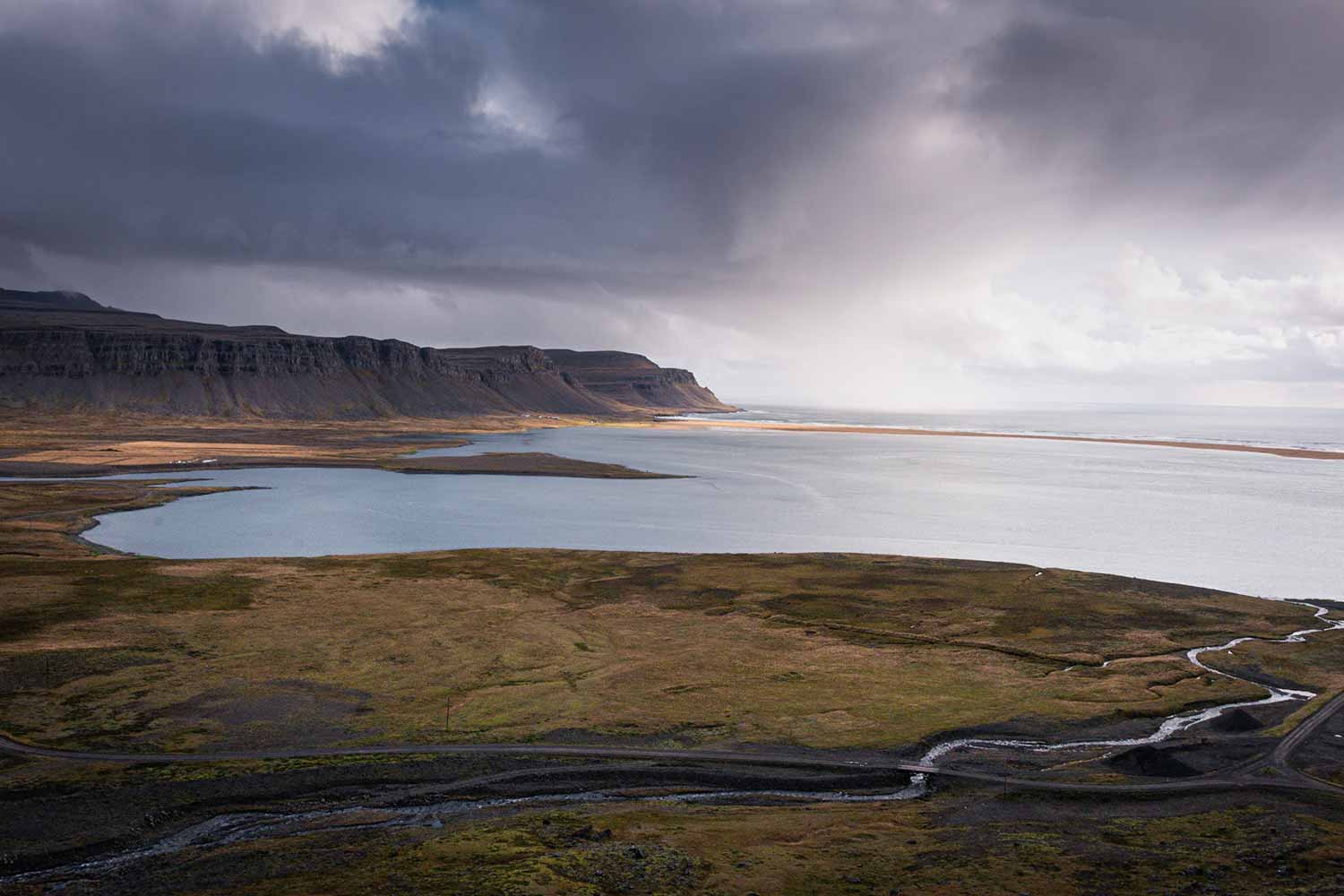
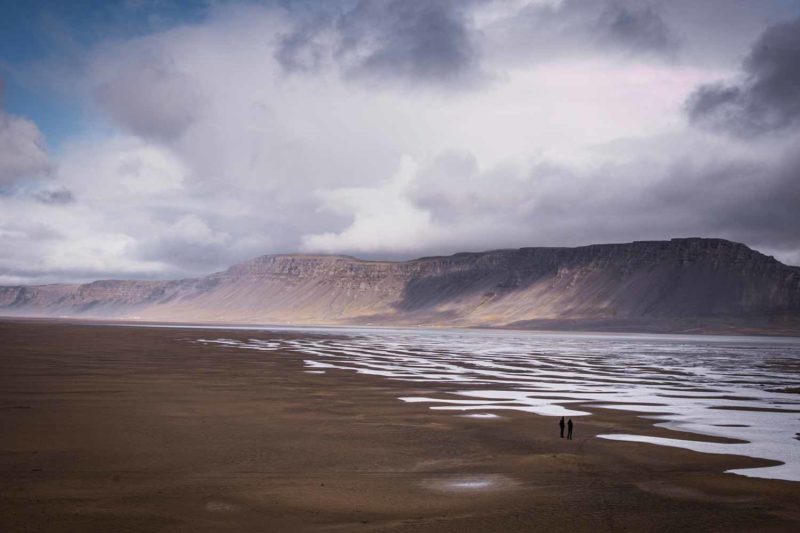
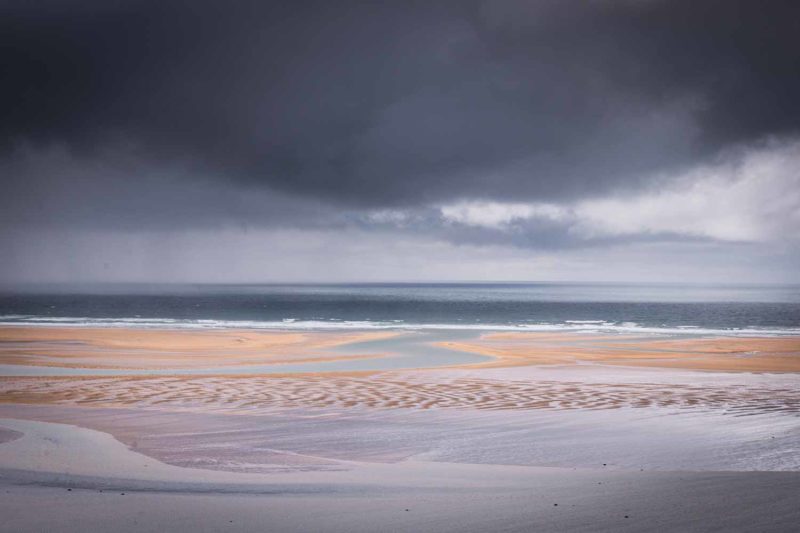
The gorgeous Raudasandur beach.
I visit the small museum next to the guesthouse. The places are full of tools and pictures of the past life. Models of boats. Seal or bird hunting tools. Clothes and ustentiles. Wooden books. Bibles with horny pages. I walk through the past, through memories. In one corner are the remains of the English trawler, the Dhoon who run aground at the foot of Latrabjarg in December 1947. The story of the saving expedition led by local farmers to rescue the crew is quite incredible. Impossible to save by sea, they had to hoist one by one the men in poor condition via ropes along the cliff. The complete rescue took almost a week. And then there is wool. A dozen blocks of wool of different colors placed on the floor of the museum. What remains of a group of sheep that lived wildly for decades on the plateau of the Talkni mountain range above Patreskfjördur. In September 2009, the group was finally captured after many unsuccessful attempts. They were captured and slaughtered. Having become wild, according to the law of men they could not continue to live freely on the mountain. The men who caught the sheep noticed that they looked different from the usual sheep. With longer legs, more muscles and less “sheep” behavior. I read the description explaining the benefit of the operation but I cannot hide a feeling of shame. Despite the very difficult conditions, especially in winter, these sheep had adapted and evolved. They had turned into wild animals. They had gotten rid of their ties to men. And that is what cost them their life.
My last day along the South Westfjords coast was a day in hell. I leave Hnjotur under a headwind as strong as yesterday. But I have to move on. I booked the ferry to Stykkishólmur on the Snaefellsnes peninsula leaving at 6pm from Brjanslaekur. With the wind so strong, I worry a bit about the prospect of reaching the ferry on time. A violent gust makes my bike roll and I find myself on the ground. A good start!. The rain fell violently for hours and scraped my face. I am soaked and panicked. It is the storm. The Icelandic storm. Violent and unbeatable. I beg for help, for a car to stop and save me from this deluge, but nobody, absolutely no one offers me help. Under the storm, with a bike, you are alone. I push my bike along the Kleifaheidi mountain pass. 404 meters high in the snow. I reach the pass around 1pm as I had hoped. And the rain finally stops. There is even a ray of sunshine. A miracle! The descent on the other side is fast and I go along the sea, amazed: there is no wind. I had expected to make the remaining thirty kilometers with a horrible headwind, but on this side of the mountain, the gods of heaven have decided to give me a break.
Around 2pm I stop for lunch quickly but a notification on my phone informs me that because of bad weather, the ferry now leaves at 4pm! I have twenty kilometers to go! I repack my sandwich and leave at full speed. But a few kilometers later, the rain and wind resume. I draw on my last strength to pedal as fast as possible. It is out of the question that I miss the boat after the horrible day I went through. Brjanslaekur finally appears at the same time as the ferry coming from Stykkishólmur. It is 3:40pm. A group of Italians applaud my exploit. Ten minutes later, the ferry is gone, it is not even yet 4pm. In the rush and the cold, I did not have time to appreciate my last moments on the Westfjords. Everything happened too fast.
I undress, trying to dry my wet clothes. I am cold. I am leached. But the relief of being able to reach the ferry and finally being safe is overwhelming. The crossing to Flatey, the only small island still inhabited in the large bay of Breidafjördur goes smoothly. Despite the waves, the boat does not move too much. That surprises me a little. We collect about ten people on Flatey, then leave through the many small islands that dot Breidafjördur. And hell start again. The boat moves on all sides, buoyed by big waves. Coldness, fatigue, seasickness and worry fall on me and I feel at the edge of faintness. The other passengers are throwing up their meals one after the other. I can not move, prostrate on the ground. Two hours in hell, wondering if I will survive. Of all the ferry crossings I made whether in Japan or from New Zealand to Australia or going to Corsica, today was the worst. But the boat reaches safely Skykkisholmur in the early evening and drops me off on land. I walk the last meters separating me from the hostel where I booked a night, trembling under the storm even stronger here. It is hard for me to regain my senses after the day I just spent. Probably the hardest of my trip. But the heat of the hostel and a good hot shower calm me a little. Despite the storm outside I decide to brave the elements one last time to have dinner in the restaurant next door. After today’s hell and not even be able to celebrate the end of my journey across the Westfjords, it is a pleasure I am entitled to am. A big seafood stew (mussels, scallops and cod) calms my stomach still a little upset after the crossing. Meringue, rhubarb and cream for dessert and I surrender to the arms of Morpheus.
Iceland has won. The weather was angry for a week and next week does not look very good either. The elements are monsters in front of which I am not capable of fight. I do not want to fight. I do not want anymore. I had enough. I am tired. My trip to Iceland is far from over, I have four weeks left. But my bike trip only have a week left. So it is like that. I will enjoy my last days without forcing too much. I will do what I can. Iceland has won.
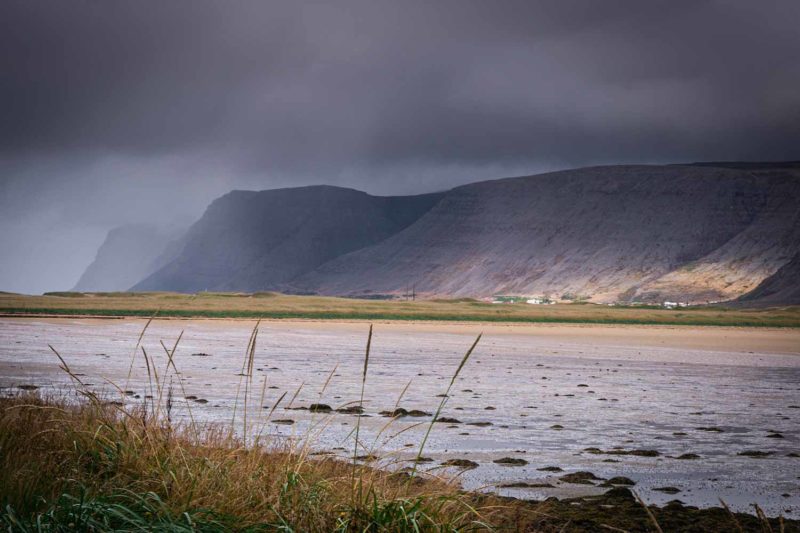
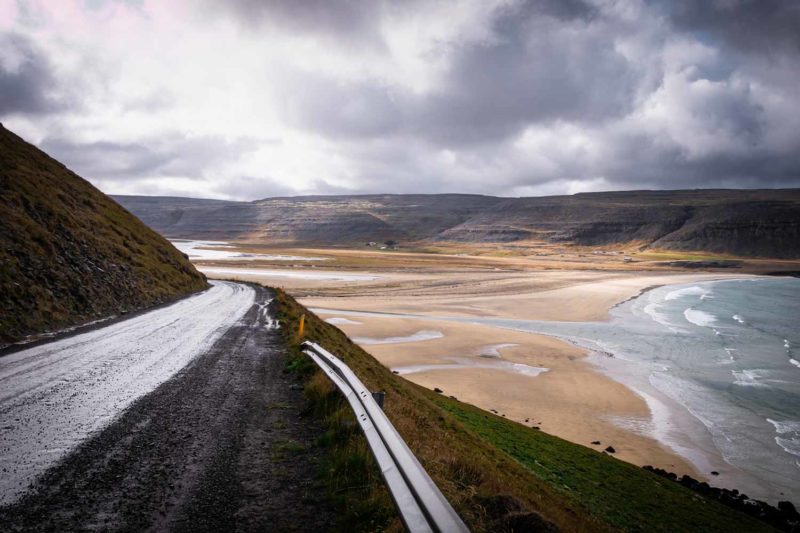
Patreksfjördur and Hnjotur bay.
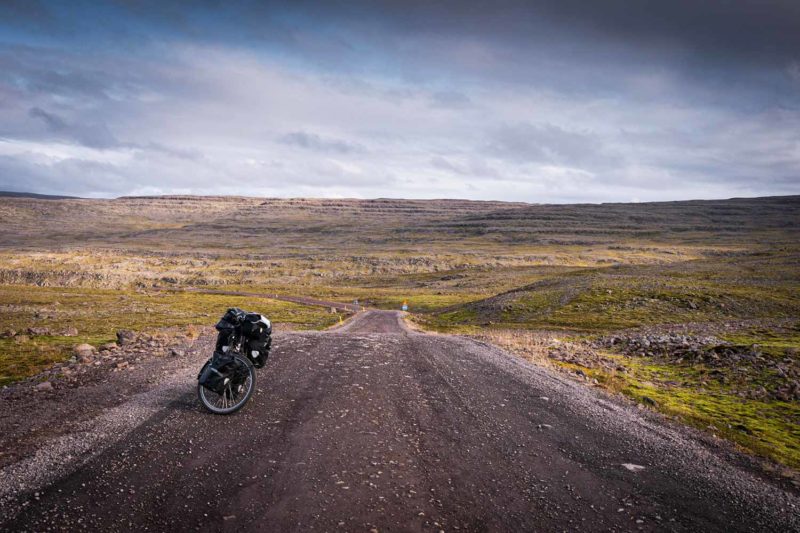
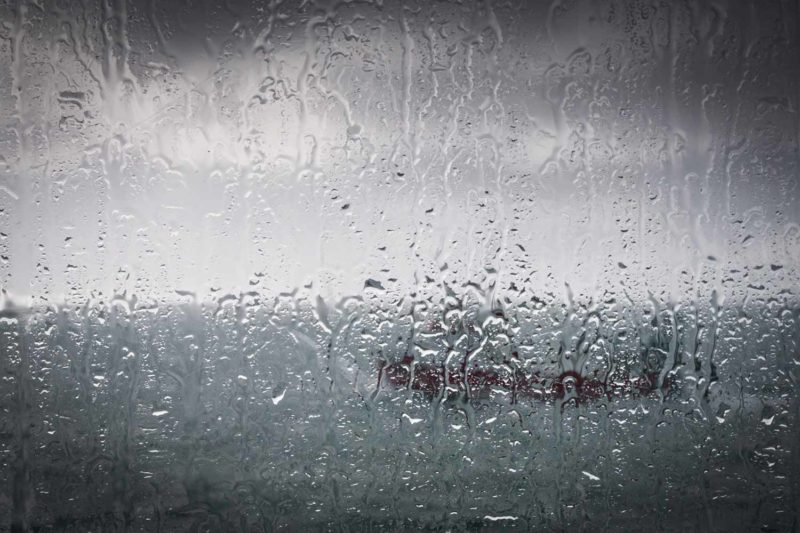
On the left, my bike on the road to Latrabjarg and on the right, on the ferry to Stykkisholmur.
